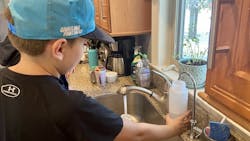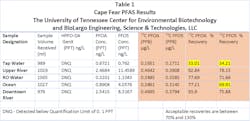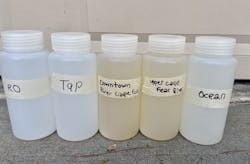North Carolina Middle School Students Test for PFAS
About the author:
Tonya Chandler is director of strategic marketing and business development for BioLargo In. Chandler can be reached at [email protected].
What do homeowners, small businesses, regulators, fortune 500 companies, and two Wilmington, NC 7th graders have in common? They are all concerned about PFAS.
Water contamination by per- and polyfluoroalkyl substances (PFAS) is a hot button issue around the world, with governments and scientists racing to find solutions to the crisis. Noah Loop and Cooper Bishop, 7th graders from a Wilmington, North Carolina middle school wanted to know just how far PFAS contamination had reached in their community. They approached Travis Loop (Noah’s Dad) about an idea for their science fair project: testing water from a variety of nearby locations for PFAS contamination.
A Call for PFAS Testing Assistance
PFAS water testing is expensive and takes skill to prep – much more than two 7th grade students could manage, but the story the project could tell could have a big impact. Knowing the cost of testing, Travis reached out to his contacts in the water community on LinkedIn to help.
“I didn’t want to discourage them on such an important topic, but I knew that they would need some assistance. PFAS testing is very costly, and this was for a 7th grade science project,” said Travis Loop, founder and producer of waterloop, a nonprofit podcast. “I was hoping someone would be willing to give us some guidance.”
BioLargo inc. answered Travis Loops appeal. BioLargo is a Life Science company based in Westminster, California. Its focus is to invent, develop, and commercialize innovative platform technologies to solve challenging environmental problems.
The BioLargo CEO Dennis Calvert read the post on LinkedIn and knew that the company wanted to help share this awareness of PFAS and foster the learning of water awareness in the next generation. BioLargo reached out to Travis with the offer to help.
“We are always looking for ways to engage in the community and promote scientific research and development in our younger generations,” Calvert said. “Our motto is ‘we make life better’, and to do that we have to keep the next generation interested in environmental issues.”
BioLargo is paving the way to finding better solutions for PFAS removal from drinking water streams. Partnering with the University of Tennessee, the company answered a call from the U.S. EPA, and through the help of a federal grant, developed new technology for PFAS removal from water. It worked with the University of Tennessee to come up with a measurement tool to test for PFAS fate in the system to ensure removal. The U of T’s skilled technicians also honed a testing method that allowed for lower detection limits, coming closer to the extremely low tolerance limits the EPA is aiming to institute.
What are PFAS?
PFAS are a group of man-made chemical contaminants that are associated with a host of serious health problems in humans including cancer, thyroid disorders, and immune deficiencies. They have gained attention in recent years, going from undetected to the Big Screen, due multiple studies and reports that have surfaced, proving PFAS are contaminating public water sources around the world. Although they are common in our everyday lives in products as cleaning products, packaging, electronics, and kitchenware, there is a movement to limit human exposure. Currently, governments around the world are struggling to enact effective measures to combat PFAS contamination.
PFAS compounds bioaccumulate, meaning they build up in an organism. They have been attractive to manufactures for years due to their strength and durability. This same chemical hardiness makes PFAS remain in the environment or in animals without being degraded or digested.
The students collected water samples from a variety of sources in the Cape Fear area near Wilmington NC including tap water, reverse osmosis (RO) water from a home filter, river water (Upper Cape Fear River and Downtown Cape Fear River), and Wrightsville Beach ocean water. Noah and Cooper sent that water to BioLargo, who started the first phase of the analysis in conjunction with nearby University of Tennessee. The results that came back shocked all parties involved.
PFAS Testing: EPA Method 537.1
The analysis of the five samples were performed using EPA Method 537.1, which is the approved method for potable and waste waters to quantify PFAS compounds. The method encompasses Liquid Chromatography accompanied with tandem mass spectrometry (LC-MS-MS). This analysis method is a powerful analytical technique that combines the separating power of liquid chromatography with the highly sensitive and selective mass analysis capability of triple quadrupole mass spectrometry.
PFAS Testing Results
The results indicate that PFAS has spread in detectable quantities beyond the borders of industrial sites and into the surface waters around Cape Fear. While the values are below proposed Federal standards, it is possible that the concentrations will continue to grow, causing bioaccumulation in numerous species in and around the Outer Banks, including game fish and other food sources.
Several interesting results appeared in the results including no quantifiable concentration of GenX was detected in any of the five samples, at a detection quantification limit of less than 1 part per trillion (ppt). The second notable finding is the relatively high concentration of PFOS in the Upper River sample. This result of 11.5 ppt is still well below any proposed Federal regulatory limit, but well above limits being set across the country for potable water. Thirdly, the ratio between the PFOS and PFOA for the Upper River sample and the Downtown River Sample is also worth some investigation.
The RO water sample shows detectable quantities of both PFOA and PFOS. This is interesting and demonstrate that RO may not be 100% efficient at removing PFAS, contrary to information cited from numerous RO manufacturers. It is important to note that the concentrations found in the RO Water are low and would typically be below the demonstrated limit of detection of the method. Finally, the fact that measurable quantities of both PFOA and PFOS were found in the ocean water sample suggests that the spread of PFAS chemicals is significant.
Although this testing was based on a small sampling done for a science fair, a good deal can be learned from the results; more than two seventh grade students could have imagined. The data shows a cross section of just how far reaching PFAS contamination can be in a single community. Five samples, all showing some level of PFAS, all in areas that have the potential to impact the daily lives of citizens in that area.
Methods of Treatment & Disposal
The abundance of PFAS in the environment and their hardiness present a challenge to would-be treatment solutions due to the difficult to break down or separate from water through standard treatment methods without significant costs (i.e. even an RO could not completely remove them).
Currently, common water treatment solutions utilized to address PFAS contamination, as recommended by the EPA, include granulated activated carbon (GAC), powdered activated carbon, RO, nanofiltration, and ion exchange. All these technologies are cost- and labor-intensive, and implementation of these technologies is considered difficult for smaller communities that may have limited capital and may not have access to full-time operators. Implementing these technologies at large-scale municipal water treatment facilities can be an enormous task due to the scope and cost of the capital cost of purchasing or retrofitting existing facilities.
Disposal of PFAS-laden materials, including PFAS-laden waste from water treatment (spent carbon and resin) is the cause of much debate across the country. While some wish to take a store it and wait approach, others wish to take a more aggressive approach, banning all incineration or land disposal of the waste. Currently, no regulations exist surrounding PFAS-laden waste, but there are discussions in the EPA over limits on water, wastewater, air and disposal. Landfill disposal and Incineration are the two most accepted practices. Current discussions include the classification of PFAS waste as RCRA.
Companies like BioLargo and others are working to find better solutions for PFAS removal, but the natural makeup and strong chemical bonding make the process energy intensive, driving up the cost of both materials and operations. Recently, BioLargo started to offer a commercialized version of its PFAS removal process called the Aqueous Electrostatic Concentrator or AEC as it is commercially known. It uses the natural chemical properties to its advantage, utilizing polarized membranes and electrodes to “pull” the PFAS from the water. This method can be used alone or in conjunction with another treatment method.
Additional Research
Loop and his partner are in good company when it comes to PFAS research. The University of North Carolina is also doing research in PFAS, focusing on the Cape Fear River water. Getting students interested early, will feed our university system with students eager to take on tough water problems like these.
“It is startling how much my children and many of their friends in Wilmington know about water pollution and PFAS specifically,” said Travis Loop. “But that will ultimately be a good thing for public health and the environment as they grow up.”
Regulators across the country are struggling with what to do about PFAS. As the list of PFAS containing chemicals continues to grow, the technology to remove them from the water streams efficiently and economically has not. In December of 2020 the EPA released an Interim Guidance for public comment on the Disposal and Destruction of PFAS Compounds, and in December 2021, EPA finalized the Fifth Unregulated Contaminant Monitoring Rule (UCMR 5), which includes 29 PFAS compounds.
The guidance indicated a desire to regulate the compounds but acknowledges that there is a lack of technology to do it affordably and efficiently, and that the analytical practices are still in development. There are discussions surrounding the regulations of PFAS not only in drinking water, but also in wastewater (making it part of the NPDES discharge regulations) and in air emission standards. All of these regulations have met with some resistance as it places a financial burden not only on businesses but also on municipal entities.
There is still some question as to what will happen with the regulation of PFAS and how fast it will move. As with most things, the science and the economics do not see eye to eye.
One thing is for certain in the midst of all the debate and ongoing research to find the best solution; as it has since 1950, PFAS will continue to accumulate in water, soil, animals and humans. This is something that even 7th graders can understand.
Author’s Note: Noah Loop and Cooper Bishop had a great time with their science fair project, learned a great deal about PFAS and were happy with their 95% grade (we will work on the proper citation format for next year)



